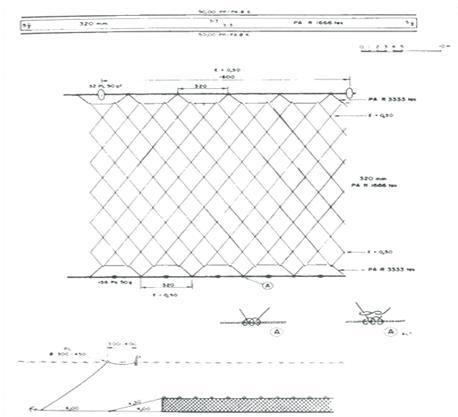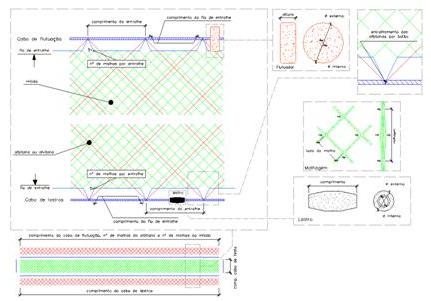Gillnets and Trammel nets
Fishing method using a rectangular net with one, two, or three cloths held upright by float cables and ballast cables used alone or in hunting
Gillnets and Trammel nets
Breadcrumbs
- Fisheries
- Fisheries
- Professional Fishing
- Local and Coastal Fisheries
- Fishing Gear
- Gillnets and Trammel nets
![]() Framework
Framework
Fishing method that uses a rectangular net with one, two, or three cloths held upright by flotation cables and ballast cables used alone or in hunting.
![]() Description
Description
Gillnets can be fixed to the bottom using anchors or poitas and set directly on the bottom or at a certain distance from the bottom, with the hunts signaled on the surface.
Drift gillnets are maintained on the surface or at a distance below it by means of numerous buoys.
The trammel nets are anchored gillnets consisting of three overlapping netting, the two outer ones (alvitanas) identical and with large meshes and the inner (small), higher, of smaller mesh.
When the fish find a trammel, they easily cross one of the great meshes of the alvitana and push the kid through the meshes of the second alvitana, thus being trapped in a kind of bag or purse.
At sea, the use of drift trammel nets is prohibited.
The nets can be set from the ground.
The only legal arts of this type are majoeiras.
![]() Features
Features
The maximum length of the set of hunts that each vessel can use is defined according to the size of the vessel.
In the case of gill nets, they vary between 2000 m and 15000 m, with a maximum height of 10 m. In the case of 60-79 mm gillnets the maximum height is 3.5m.
In trammel nets the length varies between 4000 m and 20000 m, with a maximum of 5 m in height.
In trammel nets, the minimum ratio between small mesh and that of alvitanas is 1 to 4.
Majoeiras nets can be up to 10 m long and 2 m high, and each fisherman can use up to 8 nets.
Drift gillnets can be up to 500 m long and 10 m high.
![]() Mesh classes
Mesh classes
Depending on the species to be captured, different mesh sizes can be used: 50-59mm, 60-79mm, 80-99 mm and> = 100 mm.
Drift gillnets can be used with mesh sizes between 35 to 40 mm.
The minimum mesh size of majoeiras nets is 110 mm in the small and 500 mm in the alvitanas.
Only vessels in the local fleet can be licensed for more than one class of mesh gillnets at the same time.
![]() Target species
Target species
Drift gillnets with 35 to 40 mm mesh: 70% of target species (sardines, bogue and jew).
The main species eligible for capture by gillnet and bottom trammel nets, with 70% of target species, are as follows:
- Gillnets with 1 bottom 50 to 59 mm - tongue
- Gillnets with a backdrop of 60 to 79 mm - mullet, cuttlefish, pout, redheads, sparrows, redfish, ryegrass
- Gillnets of 1 and 3 cloths 80-99 mm - sea bass, whiting, turbot, plaice, sole and hake
- > 220 mm - monkfish that can only be on board in quantities greater than 30% if the operation occurs with this minimum mesh size
- Prohibits the capture of crustaceans (maximum 5%).
![]() Area of action
Area of action
Drift nets from 35 to 40 mm: out of 1/4 mile distance to the coast line, for vessels with CFF up to 9 m, and out of 1 mile distance to the coast line, for the rest vessels.
General rule for vessels with gillnets and bottom trammel nets: Out of 1/4 mile distance to the coast line, for vessels with CFF up to 9 m, and out of 1 mile distance to the coast line, for other vessels, up to 200 miles away from the coast.
With regard to trammel nets, out of the 20 miles away from the coastline, only nets with mesh size (fine) greater than 220 mm may be used.
Majoeiras have no operating limitations in relation to the coastline.
Depending on the areas of the Captaincies
Gillnets with 1 bottom 50 to 59 mm can only be used in the area of ??the Captaincy of Vila Real de Santo António and bordering captaincy.
Gillnets with a backdrop of 60 to 79 mm cannot operate in the range between the parallel that passes through Penedo da Saudade - S. Pedro Moel (39º 45 '08''N) and the parallel that passes through Cabo de São Vicente (37º 01 '45''N).
The 80 mm to 99 mm trammel nets may only be used up to a limit of 20 miles from the coast, in the area bounded to the north by the coastline, to the south and to the east by the boundary of the sub-area of ??the EEZ continent and the west by the meridian that passes through the Cape of São Vicente lighthouse (8th 59 '8' 'W.) vessels registered in the Captaincies of Lagos can be licensed to Vila Real de Santo António.
![]() Other constraints
Other constraints
Maximum liming time: 24 hours, except for nets (mesh ≥ 100 mm) operating in zones of depth greater than 300 m that can remain silent for up to 72 hours.
Gillnets and bottom trammel nets are prohibited in an area of the Costa Vicentina between 37º 50´N and 37º 00´ in December and February.
It is prohibited to fish in the “Beirinha” on the Algarve coast between 7º 31´W and 7º 47´W.
The bottom bottom gillnets for tongue fishing (50 to 59 mm) cannot be used between March and May, in the Captaincy area of Vila Real de Santo António and Tavira, by vessels of the local fleet registered in Vila Real de Santo António.
![]() Images
Images


![]() Legislation
Legislation
Ordinance No. 296/94, of 17 May, which updates the national legislation in force with regard to zones and periods of fishing prohibition.
Ordinance No. 213/2001, of 15 March, which prohibits fishing with gillnets anchored by cloth and trammel nets in the Beirinha area.
Order No. 12770/2010, of 9 August, which sets out the criteria and conditions for licensing for fishing with majoeira.



